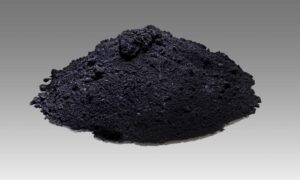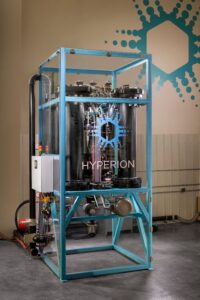
Pristine graphene
Canadian Plastics
Canadian Plastics Materials Packaging Research & DevelopmentOntario-based HydroGraph Clean Power is one of the world’s purest producers of graphene. And the company is now using the substance to improve performance and reduce material usage in plastics.

Graphene powder. Photo Credit: HydroGraph Clean Power Inc.
You can be forgiven for perhaps not knowing a whole lot about graphene – it’s only been around since 2004, when two British scientists at the University of Manchester created the world’s first single-layer graphene flakes by peeling a sheet of material from a graphite pencil tip using only sticky tape.
It may have been an inauspicious start, but graphene more than makes up for this by virtue of its unparalleled performance. Indeed, it’s a true supermaterial, seemingly right out of science fiction – a one-atom-thick layer of carbon atoms bonded together in a hexagonal lattice, the substance is 200 times stronger than an equally thin piece of steel and yet 1,000 times lighter than paper, harder than diamond, more conductive than copper, holds together at temperatures of up to 1,300°F or 700°C, and can withstand acids.
So, it’s no wonder researchers around the world have been studying ways that graphene can advance material science and technology, especially as a replacement material for carbon fibre and other carbon fillers, the uses of which have stalled because of high costs and availability. But the results have been sketchy so far: after 20 years, graphene is only just starting to be used in real-world applications, due mainly to the fact that it’s difficult and expensive to manufacture at commercial scales.
TESTING, TESTING…
But a Canadian graphene manufacturer is aiming to change this, and is proving it, in part, by combining the substance with polyethylene terephthalate (PET) in blow molded bottles to improve the plastic’s performance and reduce material in the bottles by between 10 to 15 per cent. HydroGraph Clean Power Inc., headquartered in Toronto, is one of only five certified graphene makers in the world, and recently finished testing to assess if its 99.8 per cent pure carbon content fractal graphene – called FGA-1 – would enhance the mechanical properties of PET. “Testing was done at the Graphene Engineering Innovation Centre [GEIC] at the University of Manchester, which specializes in the rapid development and scale-up of graphene and other 2D materials applications,” said Ranjith Divigalpitiya, HydroGraph’s chief science officer. “Tensile testing showed an increased elasticity of 22 per cent at 0.5 per cent graphene weight, increased strength at breaking by 114 per cent from virgin PET, and increased strength at yield of between 13 to 15 per cent.” And by having a total of between 10 to 15 per cent less material in the bottles overall, he continued, manufacturers will also save on energy from reducing the need to heat and cool the material. “The savings are considerable,” Divigalpitiya said.
And as new as graphene is, HydroGraph’s graphene is even newer, due to being produced using the company’s patented Hyperion controlled-explosion system at its production facility in Manhattan, Kan. “Traditional mass graphene manufacturing uses mined graphite, which is energy-intensive and expensive, while resulting in a very impure type of graphitic material that’s primarily graphite, not pure graphene – and they’re making it at a very small scale,” Divigalpitiya said. By contrast, HydroGraph’s Hyperion gas-based detonation process works by filling the unit’s chamber with acetylene and oxygen and then igniting the mixture with a small spark. “The graphene is synthesized very quickly during that explosion, in a 15-millisecond reaction,” Divigalpitiya said. “It’s a high-yield process that creates a super clean 99.8 per cent pure graphene powder, 2- to 7-layers thick, identical from batch to batch, and using very little energy. It actually takes more energy to extract the powder produced in the reactor than to create it.” The Hyperion method is exothermic, Divigalpitiya explained – in other words, it releases heat, unlike other graphene production methods, all of which are endothermic, or heat-absorbing. “That means we don’t need to draw energy out of the grid or burn a fossil fuel to create the energy that converts the hydrocarbon to graphene,” he said. “This low energy consumption, along with the absence of emissions and reduced waste product, make it the most environmentally friendly manner of making graphene. No one else in the world is making graphene the way we are.” And Hyperion is ideal for commercial-scale graphene production, Divigalpitiya added, being capable of producing 10 tons of graphene per year.
FROM KANSAS TO CANADA
The Hyperion system was created by Dr. Chris Sorensen, a professor in the department of physics at Kansas State University, and who also serves as HydroGraph’s vice president of research and development. “Chris invented the process in 2017 and we’ve licensed the technology worldwide with Kansas State University,” Divigalpitiya said. “With support from our funding, the technology was further developed and scaled up as a manufacturing process, and we commercialized it two years ago.”

HydroGraph’s Hyperion system. Photo Credit: HydroGraph Clean Power Inc.
One of HydroGraph’s goals is to make its graphene widely available so that more manufacturers – in plastics and beyond – can incorporate graphene as an additive material, and Divigalpitiya highlights the Hyperion reactor’s compact size and modularity as benefits. “The footprint of the Hyperion platform is modular and very small – 2 meters by 2 meters and 4 meters high – so we can set up a reactor near feedstock sources that provide the oxygen and acetylene, reducing the need for transportation,” he said. “We can also build close to the customer to minimize supply chain risk.”
HydroGraph was formed in 2017, and its founders eventually pivoted from exploring the properties of graphene into formulating ways for an environmentally friendly process to produce it. The company currently has three locations: a lab in London, Ont., from which – in 2022 – the company secured a $90,000 grant in funding per year for two years for composite work at the Fraunhofer Innovation Platform for Composite Research at Western University; a Kansas plant in the community of Manhattan near Kansas State University; and a lab at the University of Manchester’s GEIC. “Manchester is known as ‘the home of graphene,’ since that’s where it was first isolated as a 2D material, so it’s important for us to have a presence there,” Divigalpitiya said. “We’re initially concentrating at GEIC on application areas aligned with our strategic focus of composites, coatings, and energy storage, and we can scale up to include other application areas based on market demand.”
In its Manhattan, Kan., location, Divigalpitiya continued, HydroGraph has physically co-located R&D and manufacturing together, in the same building. “There’s little-to-no barriers between these two critical groups, which facilitates communication and idea generation between them, so we have manufacturing working shoulder-to-shoulder with physicists, chemists, biologists, and engineers,” he said. “Basically, this type of organization is non-existent among mature corporations today, but it’s seen more with smaller start-ups.” The company currently has about 18 full-time employees in total, he added.
BOTTLES AND BEYOND
As demonstrated by its recent testing of graphene in PET bottles, plastics is one of HydroGraph’s main areas of concentration at present. “We had already selected polymer composites as an exciting growth area, and then our involvement with PET came when an existing bottle molding customer asked us to test graphene with PET,” Divigalpitiya said. “What we’ve learned is that graphene is an excellent additive for PET because its very thin geometry makes it easier to go into the polymer structure than other fillers, and it also adds strength and thermal stability – in extrusion compounding, for example, the customer can actually improve throughput with our material. As far as handling the graphene by the operators on the shop floor, it can be treated like any other drop-in solution.”
In the short term, Divigalpitiya continued, HydroGraph’s next steps with PET will be to prove other benefits, like recyclability and barrier properties. “We’re also going to explore if our graphene will boost the strength of recycled material, which would let manufacturers reuse a higher percentage of recycled PET in the material mix,” he said. And in the longer term, the company plans to test its graphene powder in combination with other thermoset polymers.
Divigalpitiya compares the current state of graphene to aluminum in its early years, recalling the challenge to reach mainstream acceptance. But HydroGraph hopes to be a big part of changing that. “Certain high-value applications require additional functionalization to bring enhanced, attractive properties – such as tensile strength, elasticity, and conductivity – to more complex materials,” he said. “We can tailor our graphene to virtually any application, so we believe our future is very bright as far as integrating graphene into just about any material you can imagine.”
